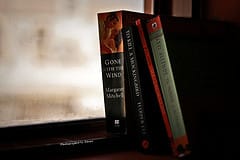 The claim that Common Core will be the death of great literature wilts under scrutiny. Photo by Zitona via photopin cc. |
To believe the latest criticisms of the Common Core is to believe that these rigorous new standards for English language arts, despite their focus on increasing the quality and complexity of the books read in English classes across grades K–12, signal the death of great literature in American schools. Like many arguments against the Common Core, however, this latest one wilts under scrutiny.
At the heart of this critique is a two-paragraph section found on page 5 of the introduction to the CCSS that mentions the NAEP assessment framework, shows the distribution of literary and informational texts across the grades (50/50 in 4th grade, 45 percent literary to 55 percent informational in 8th, and 30 percent literary to 70 percent informational in 12th), and suggests that teachers across content areas should “follow NAEP’s lead in balancing the reading of literature with the reading of informational texts, including texts in history/social studies, science, and technical subjects.”
Never mind that the document immediately clarifies—no fewer than three times!—the fact that “a significant amount of reading of informational texts take place in and outside the ELA classroom.” Denizens of the anti-Common Core fever swamps choose not to read that bit of “informational text.” They also choose to ignore the fact that the only genre the standards explicitly ask ELA teachers to spend more time teaching is literary nonfiction—something that is essential to literary study and absolutely belongs in literature classrooms.
Facts like that don’t make it into the swamps—not when there is a straw man to attack and standards to undermine! The Pioneer Institute, fronted by one-time Massachusetts education official Sandra Stotsky, led off by asserting that great works like Huck Finn and The Catcher in the Rye will be relegated to the dustbin of American education when Common Core is implemented.
Now education reform’s foremost critic Diane Ravitch has joined this fray with multiple posts on the topic. In the first of these, she acknowledged that
As readers may know, articles have appeared in the international press about the removal of well-known works of fiction from English classes. I know of no justification for such statements. The standards do not have a list of banned books.
In the two posts that followed, Ravitch focused on the “70-30% rationing of informational text to literature,” thus helping to perpetuate the myth that the CCSS aim to shift the focus in literature class from literary study to the reading and analysis of mind-numbing informational texts. She then personalizes her objections, chiding Common Core co-author (and College Board president) David Coleman, saying, “I know you have explained and explained that the Common Core is not anti-fiction, is not anti-literature. But when you have to keep explaining, that means you have made a mistake.” Then she adds, “Those who agree with you are paid to agree with you.”
Besides the squalid nature of that outrageous and insulting statement, people who say things like that are inadvertently signaling how weak the substantive foundation of their argument actually is. Consigning those who agree with Coleman about English language arts to the ranks of bribe-takers or sell-outs doesn’t change the facts, which point in the opposite direction of the case Ravitch is making.
Further, by focusing their attention on nonexistent informational text quotas and absurd examples of such texts, Ravitch and Stotsky—both of whom are legitimately committed to improving the quality and rigor of what’s taught in schools across the land—and their allies encourage teachers and school leaders to dwell on two paragraphs of the standards that are being misread, rather than the 200-plus pages that are aimed at helping educators select culturally significant, content-rich, and appropriately complex texts. Among the guidance in these 200 pages are lists of the kinds of fiction and literary nonfiction texts that teachers aligning their instruction to the Common Core should choose from, including:
 |
The list goes on and on with titles that are important, interesting, and almost exclusively at the top of most educators’ list of worthy reading.
Conspicuously absent from the Common Core’s guidance is anything resembling a directive to teachers to assign bus schedules, trade manuals, or technical reports. Perhaps there are publishers who are trying to include such low-level texts as part of their supposedly “Common Core-aligned” materials, but those who do are ignoring the explicit guidance from the CCSS themselves. And nobody in their right mind would purchase such things.
Those with a serious interest in improving English language arts in American schools would do better to spend time highlighting the kinds of texts that are actually recommended by the Common Core rather than perpetuating misinformation and dripping with malice.
In an irony so rich even Alanis Morissette would correctly label it, at this point the debate over Common Core implementation has become so heated that opponents of the standards are publically and repeatedly misrepresenting what the standards require in ways that will actually lead these standards to be implemented in ways that run contrary to both what they actually require and these critics’ own deeply held beliefs.
For those of who want to refocus literature instruction on teaching the kinds of rigorous, high quality texts—fiction and nonfiction alike—that students need to succeed in college and beyond, it’s time to call out the nonsense being pumped by this anti-Common Core noise machine and help teachers and school leaders focus their attention on the voluminous guidance included in the CCSS that is aimed at doing precisely that.
